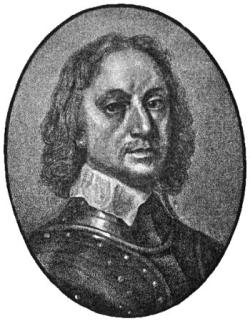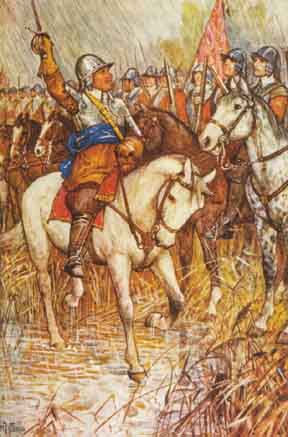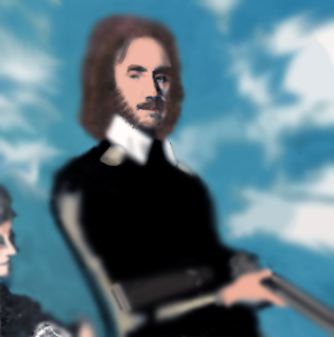Oliver Cromwell
From the Quicksilver Metaweb.
This is an intermediate page for Oliver Cromwell.
Stephensonia
Young Ben Franklin: [Oliver Cromwell] killed alot of Irishmen.
Authored entries
- The Interregnum (Neal Stephenson)
- Stephenson:Neal:Quicksilver:9:Restoration (Jeremy Bornstein)
- Stephenson:Neal:Quicksilver:21:Killed a great deal of Irishmen (Alan Sinder)
- Stephenson:Neal:Quicksilver:94:found God (Neal Stephenson)
Community entry: Oliver Cromwell
from various Wikipedia sources
Oliver Cromwell (April 25, 1599 - September 3, 1658) was an English politician; who, as Lord Protector following the overthrow of the British Monarchy, ruled England, Scotland and Ireland from December 16, 1653, until his death.

When the English Civil War broke out, Cromwell raised a cavalry troop which became the basis of his Ironsides[1]. It was at the Battle of Marston Moor (1644) that Cromwell came to prominence. As a leader of the Parliamentarian cause, and commander of the New Model Army which he was instrumental in forming, he defeated King Charles I's forces, thus bringing to an end the absolute power of the English monarchy.
Ironsides
Ironsides was a nickname given to a soldier in the cavalry troop formed by Oliver Cromwell early in the English Civil War; these soldiers would form the nucleus of the New Model Army. The Ironsides' use of armour and their disciplined formation and obedience to their commanders, at a period when the majority of both armies consisted largely of ill-equipped rabble, made them virtually invincible.
New Model Army
The New Model Army was the most famous of various Parliamentarian armies in the English Civil War. It was an army of professional soldiers led by trained generals in an era when aristocrats with no guarantee of military training led most armies. They also became famous for their Puritan religious zeal.
New Model Army was formed from the existing Roundhead forces on February 15, 1645 onwards when Oliver Cromwell passed the Self-denying Ordinance to remove the former leadership of the Roundhead forces. It was led by Thomas Fairfax and at first Cromwell was only in the charge of the cavalry. It finally came into being in April.
New Model Army consisted of 22.000 soldiers, including 11 regiments of cavalry (6600 men), 12 regiments of infantry (14400 men) and 1 regiment of 1000 dragoons. Soldiers were conscripted from all over the country and older regiments were merged to join the army.
Leadership and promotions were meant to be based on proficiency instead of social standing or wealth. However, Cromwell also preferred soldiers that were devoted Puritans like himself and some of them sung psalms prior to battle. He also instituted standard daily pay (8 cents for infantry, 2 shillings for cavalry) and guarantee of food, clothing and other provisions. Cavalrymen had to supply their own horses.
Cromwell merged men from multiple regiments into a single one and provisioned them with red uniforms to replace their former regiment colors. "Soldier's catechism" dictated new regulations and drill procedures.
Prince Rupert, one of the King's followers, nicknamed them as Ironsides. However, this was more due to their ability to cut through opposing forces than their armor, as has been sometimes claimed; their armor was composed of leather jerkins.
Tactics of the New Model Army were based on fast hit-an-run attacks against the flanks of the enemy. Frontal attack would have meant exposing them to the Royalist artillery. Cromwell specifically forbade them to pursue a fleeing enemy and hold the battlefield.
Cromwell and his Kinghts
Ironsides and his Ironsides
New Model Army won important victories at Naseby (when they were first used) and Preston. After the end of the civil war, they fought in Scotland, Ireland, Flanders and Spain. After the campaigns in Ireland in 1640's some of them retired to settle in what is now Northern Ireland.
In November 1647 the Army held an important debate about political, constitutional and religious issues in St Mary's Church, Putney.
During the First World War, Douglas Haig re-introduced the term for his units of the British Expeditionary Force. This army was soon decimated at the Somme, and the term became something of a joke.
Family and Childhood
Oliver Cromwell descended from Catherine Cromwell (born circa 1483 ), an older sister of Tudor statesman Thomas Cromwell. Although she married, her children kept her name, possibly to maintain their connection with their famous uncle. Of these children, Richard Cromwell (c 1500 -1544 ) was the father of Henry Cromwell (c 1524 -January 6,1603 ). Henry's extravagant tendencies left his heirs including his son Robert Cromwell, Esquire (c 1560 -1617 ) with an inheritance that included lands but not money. Oliver was born to Robert Cromwell and his wife Elizabeth Steward or Stewart( 1564 -1654 ) on April 25,1599.
Oliver was born in Huntingdon, in the county of Huntingdonshire in East Anglia. He was a gentleman farmer, but had to sell his farm and land to repay debts he had accumulated. Already a devout member of the hard-line Puritan sect, he became an evangelical member.
Member of Parliament
Having decided against joining his uncle in Virginia, he instead became the Member of Parliament (MP) for Huntingdon in the Parliament of 1628 -1629. His maiden speech was defending a radical democrat who had argued in an unauthorised pamphlet in favour of giving the vote to all men. He was also prominent in defending the people of The Fens from wealthy landowners who wanted to drive them off their land.
Military Commander
Cromwell's influence as a military commander and politician during the English Civil War dramatically altered the military and the political landscape of the British Isles.
Having joined the Army with no military experience at the age of 43, he recruited a cavalry unit and gained experience and victories in a succession of battles in East Anglia. Promoted to the General in charge of cavalry in the New Model Army, he trained his men to rapidly regroup after an attack, tactics first employed with great success at the Battle of Naseby. With military success came political power, until he was the leading politician of the time.
Execution of the King
The so-called "second civil war ", which broke out in 1648 after Charles I's escape from prison, suggested to Cromwell that no compromise with the king would be possible. Many hold Cromwell responsible for the execution of Charles I in January 1649, although there were 59 signatories to the death warrant.
Scotland and Ireland
Cromwell's actions made him very unpopular in Scotland and Ireland which, as nominally independent nations, were effectively conquered by English forces. In particular, Cromwell's suppression of the Royalists in Ireland during 1649 still has a strong resonance for many Irish people. The massacre of nearly 3,500 people in Drogheda after its capture -- comprising around 2,700 Royalist soldiers and all the men in the town carrying arms, including civilians, prisoners, and Catholic priests -- is one of the historical memories that has fuelled Irish-English and Catholic-Protestant strife for over three centuries. Cromwell felt justified in ordering the massacre because the city's defenders had continued to fight, in violation of what were then the norms of warfare, after the walls had been breached.
Political Rule
In the wake of victory, the monarchy was abolished, and between 1649 and 1653 the country became Europe's first republic since the fall of the Roman Empire. The republic was known as the Commonwealth of England.
Many of Cromwell's actions following the end of the war appear unwise or hypocritical. He was savage in putting down the mutinies which occurred within his own army towards the end of the war (prompted by failure to pay the troops) and showed little sympathy for the Levellers, an egalitarian movement which had contributed greatly to Parliament's cause. His foreign policy led him into the First Anglo-Dutch War in 1652 against the Republic of the Seven United Netherlands, eventually won by Admiral Robert Blake in 1654.
With the king gone, and with it their common cause, Cromwell's unanimous backing dissolved, and the various factions in Parliament became engaged in infighting. In a repeat of the actions the former king had taken that had contributed to civil war, Cromwell eventually dismissed the republican Rump Parliament in 1653 and instead took personal control as, effectively, a military dictator.
In 1657 Cromwell was offered the kingship by a reconstituted parliament, presenting him with a dilemma since he had been instrumental in abolishing the monarchy. After six weeks of deliberation, he turned down the crown largely because the senior officers in his army threatened to resign if he accepted. Instead, he was ceremonially installed as Lord Protector at Westminster Abbey, sitting on the former king's throne, practically a coronation and a king in all but name.
Death and Execution
Within two years of Cromwell's death on September 3,1658 (his son Richard Cromwell having proved an unworthy successor), parliament restored Charles II as king.
This should have been the end of the story but in 1661 Oliver Cromwell's body was exhumed from Westminster Abbey and was subjected to the ritual of a posthumous execution - on January 30, the same date that Charles I had been executed. He was in fact hung, drawn and quartered. At the end his body was thrown into a pit; his head however was detached from his body and displayed on a pole outside Westminster Abbey until 1685. Since then it changed hands several times before eventually being buried in the grounds of Sidney Sussex College, Cambridge, in 1960.
Modern View
In 2003, Cromwell came 10th in a popular BBC poll of "Great Britons".
Oliver and Richard Cromwell
The Lord Protector and his Son
Quotes
- "Let us restore the king to his throne, and let the king in future agree to govern with the consent of Parliament. Let us restore the old church, with its bishops, since that is what most of the people want; but since the Puritans and Separatists and Baptists have served us well in the war, let us not persecute them anymore but let them worship as they like, outside of the established church. And so let us have peace and liberty."
Related entries
- English Civil War Timeline
- English Civil War
- Charles I
- Charles II
- Hugh Peters
- John Wilkins
- Judge Jeffreys
- Maids of Taunton
- Myles Coverdale
- Puritan
- Richard Cromwell
- Usurper
- Talk:CABAL
- Talk:Charles II
- Talk:Stephenson:Neal:Quicksilver:9:Restoration (Jeremy Bornstein)
- Talk:Stephenson:Neal:Quicksilver:36:According to what scheme? (Alan Sinder)
- Talk:Stephenson:Neal:Quicksilver:86:Ashkenazi (Jeremy Bornstein)